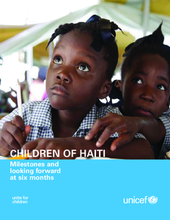Six months on, the dramatic destruction caused by the 12 January 2010 earthquake in Haiti is still synonymous with unbelievable stress for over three million people1, including 1.6 million living in 1,342 spontaneous settlements, of which 800,000 are estimated to be children. Over 220,000 people lost their lives, 300,000 were injured and 4,000 lost a limb after being caught in the rubble of what had once been a home, a school, a place for work, or a spot for the community to gather together.
Since day one, UNICEF mobilized its resources to deliver on its Core Commitments for Children, speed up provision of life-saving assistance and support the government in coordinating the response and initiating early recovery efforts. Today UNICEF is providing safe water to 333,000 people, 62,800 children are benefiting from recreational activities and psychosocial support, and more than 185,000 children have received educational materials. While this report focuses on UNICEF’s efforts, partnerships under the Cluster Approach have also been instrumental to further build on these results, and UNICEF has worked in close collaboration with the Government of Haiti, with sister UN agencies, and with numerous international and national NGOs and civil society partners that have all worked tirelessly to provide support in bringing services to children— by helping set-up schools, latrines, water-points and helping protect children and keep them healthy.
On the eve of 12 January children in Haiti were already facing tremendous threats of violence, sexual abuse, trafficking, exploitation and abandonment. Now risks have increased manifold as the earthquake exacerbated a preexisting crisis by collapsing an already inadequate and weak system that was failing to protect those most vulnerable. Children in Haiti are now caught in the midst of a child protection emergency of unprecedented magnitude. UNICEF and partners were active in Child Protection before the quake—and are now responding with urgency.
The needs of some 500,000 vulnerable earthquake-affected children are being addressed, with the immediate objective of restoring a protective and safe environment for children. To this end, partners in the UNICEF-coordinated Child Protection Sub-Cluster have worked closely with government authorities to steadily expand the identification, registration and family tracing process for separated children. The report includes specific update on children without parental care in Haiti.

